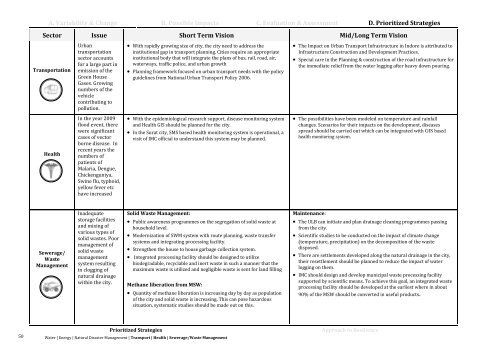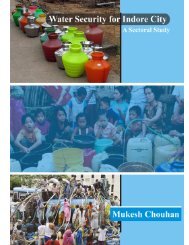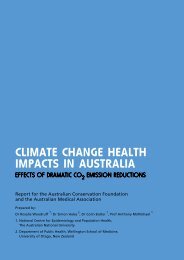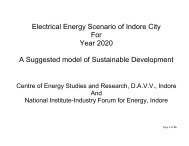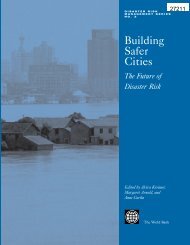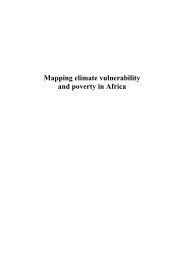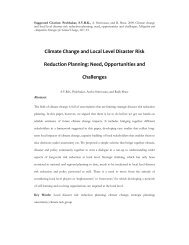Indore City Resilience Strategy - ImagineIndore.org
Indore City Resilience Strategy - ImagineIndore.org
Indore City Resilience Strategy - ImagineIndore.org
You also want an ePaper? Increase the reach of your titles
YUMPU automatically turns print PDFs into web optimized ePapers that Google loves.
A. Variability & Change B. Possible Impacts C. Evaluation & Assessment D. Prioritized Strategies<br />
Sector Issue Short Term Vision Mid/Long Term Vision<br />
Transportation<br />
Health<br />
Urban<br />
transportation<br />
sector accounts<br />
for a large part in<br />
emission of the<br />
Green House<br />
Gases. Growing<br />
numbers of the<br />
vehicle<br />
contributing to<br />
pollution.<br />
In the year 2009<br />
flood event, there<br />
were significant<br />
cases of vector<br />
borne disease. In<br />
recent years the<br />
numbers of<br />
patients of<br />
Malaria, Dengue,<br />
Chickenguniya,<br />
Swine flu, typhoid,<br />
yellow fever etc<br />
have increased<br />
With rapidly growing size of city, the city need to address the<br />
institutional gap in transport planning. Cities require an appropriate<br />
institutional body that will integrate the plans of bus, rail, road, air,<br />
waterways, traffic police, and urban growth<br />
Planning framework focused on urban transport needs with the policy<br />
guidelines from National Urban Transport Policy 2006.<br />
With the epidemiological research support, disease monitoring system<br />
and Health GIS should be planned for the city.<br />
In the Surat city, SMS based health monitoring system is operational, a<br />
visit of IMC official to understand this system may be planned.<br />
The Impact on Urban Transport Infrastructure in <strong>Indore</strong> is attributed to<br />
Infrastructure Construction and Development Practices.<br />
Special care in the Planning & construction of the road infrastructure for<br />
the immediate relief from the water logging after heavy down pouring.<br />
The possibilities have been modeled on temperature and rainfall<br />
changes. Scenarios for their impacts on the development, diseases<br />
spread should be carried out which can be integrated with GIS based<br />
health monitoring system.<br />
Sewerage/<br />
Waste<br />
Management<br />
Inadequate<br />
storage facilities<br />
and mixing of<br />
various types of<br />
solid wastes. Poor<br />
management of<br />
solid waste<br />
management<br />
system resulting<br />
in clogging of<br />
natural drainage<br />
within the city.<br />
Solid Waste Management:<br />
Public awareness programmes on the segregation of solid waste at<br />
household level.<br />
Modernization of SWM system with route planning, waste transfer<br />
systems and integrating processing facility.<br />
Strengthen the house to house garbage collection system.<br />
Integrated processing facility should be designed to utilize<br />
biodegradable, recyclable and inert waste in such a manner that the<br />
maximum waste is utilized and negligible waste is sent for land filling<br />
Methane liberation from MSW:<br />
Quantity of methane liberation is increasing day by day as population<br />
of the city and solid waste is increasing. This can pose hazardous<br />
situation, systematic studies should be made out on this.<br />
Maintenance:<br />
The ULB can initiate and plan drainage cleaning programmes passing<br />
from the city.<br />
Scientific studies to be conducted on the impact of climate change<br />
(temperature, precipitation) on the decomposition of the waste<br />
disposed.<br />
There are settlements developed along the natural drainage in the city,<br />
their resettlement should be planned to reduce the impact of water<br />
logging on them.<br />
IMC should design and develop municipal waste processing facility<br />
supported by scientific means. To achieve this goal, an integrated waste<br />
processing facility should be developed at the earliest where in about<br />
90% of the MSW should be converted in useful products.<br />
50<br />
Prioritized Strategies<br />
Water | Energy | Natural Disaster Management | Transport | Health | Sewerage/Waste Management<br />
Approach to <strong>Resilience</strong>


